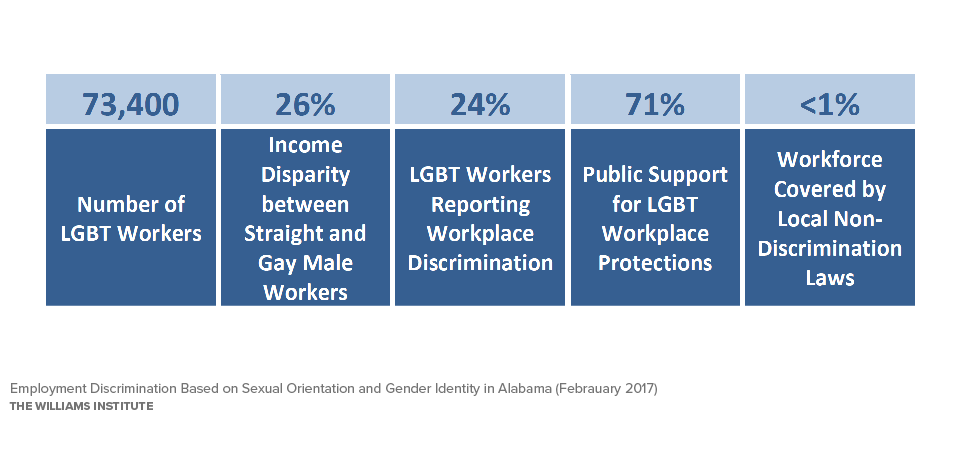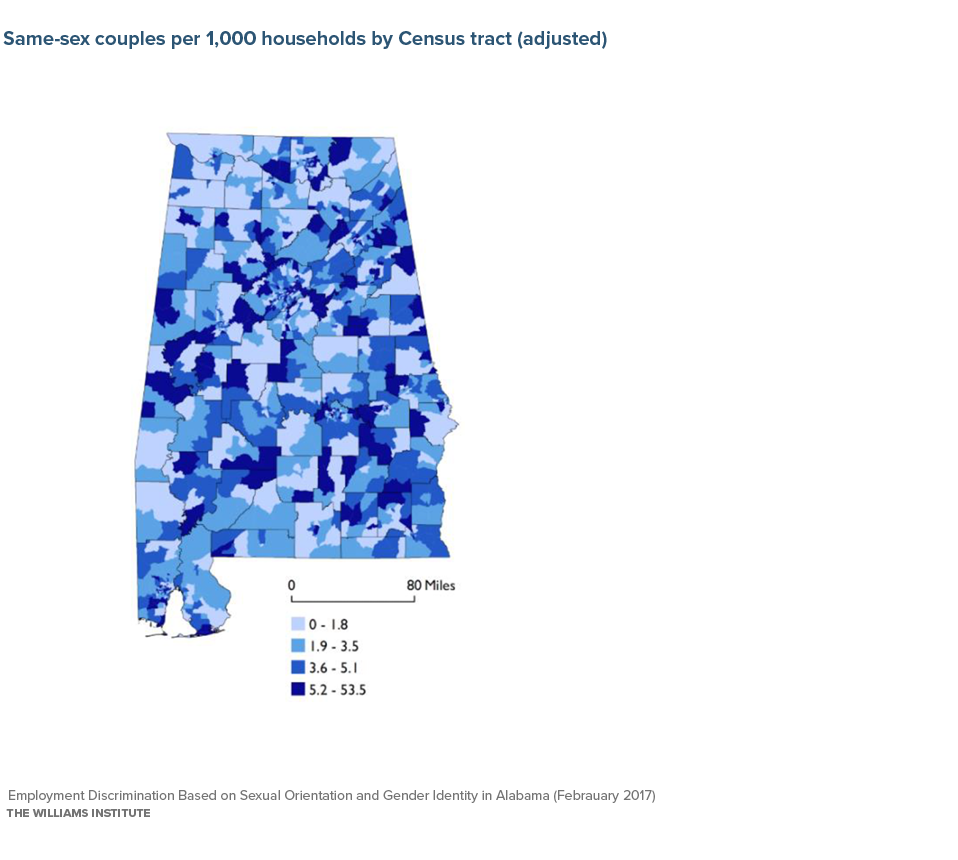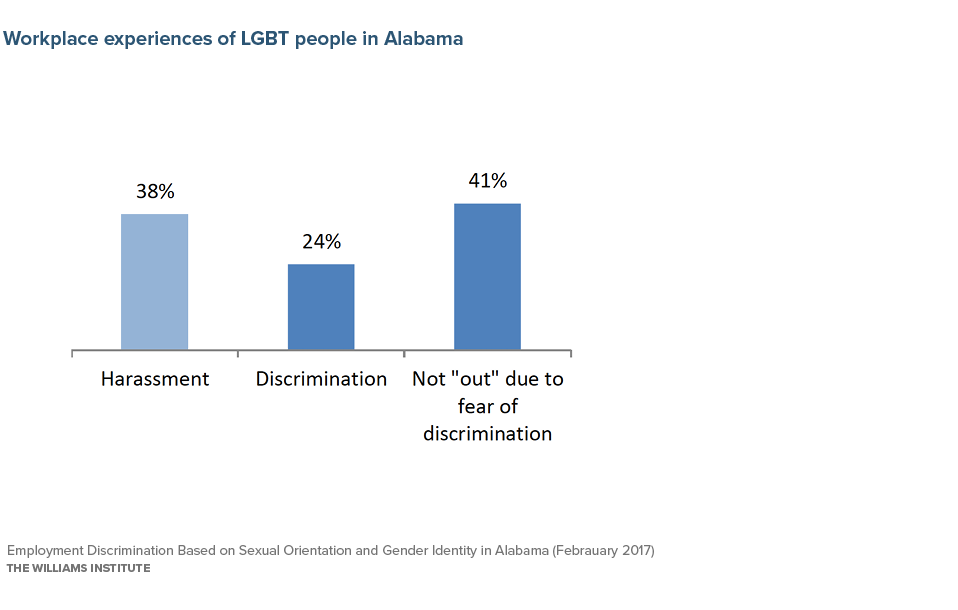Executive Summary
More than 4% of the American workforce identifies as lesbian, gay, bisexual, or transgender (LGBT). Approximately 73,400 of these workers live in Alabama. Alabama does not have a statewide law that prohibits discrimination based on sexual orientation or gender identity in employment.
This report summarizes recent evidence of sexual orientation and gender identity employment discrimination and explains the limited current protections from sexual orientation and gender identity employment discrimination in Alabama.
Key Findings
- In total, there are approximately 120,000 LGBT adults in Alabama, and 73,400 LGBT people in Alabama’s workforce.
- Surveys indicate that LGBT people in Alabama experience discrimination. For example, a 2014 survey of LGBT people in Alabama found that 24% reported experiencing employment discrimination and 38% reported experiencing harassment at work because of their sexual orientation or gender identity. In addition, 41% of respondents reported that they are not “out” at work due to fear of not being considered for advancement or development opportunities.
- National surveys also confirm that discrimination against LGBT workers persists. For example, a 2013 Pew Research Center survey found that 21% of LGBT respondents had been treated unfairly by an employer in hiring, pay, or promotions.
- When transgender people are surveyed separately, they report similar or higher levels of discrimination. For example, the 2011 National Transgender Discrimination Survey found that among respondents from the South, 92% reported experiencing harassment or mistreatment on the job, 30% reported losing a job, 48% reported that they were not hired for a job because of their gender identity or expression.
- Census data show that in Alabama, the median income of men in same-sex couples is 26% lower than the median income of men in different-sex marriages.
- One locality in Alabama, Montgomery, has a policy that protects city workers from discrimination based on sexual orientation.
- Less than 1% of Alabama’s workforce is protected from discrimination based on sexual orientation under Montgomery’s policy, and none of the state’s workforce is explicitly protected from gender identity discrimination under state or local law.
- Private companies may adopt internal non-discrimination policies to improve recruitment and retention of talented employees, to increase employee productivity and customer satisfaction, or to attract a larger customer base. At least five large, private-sector employers headquartered in Alabama have internal employment non-discrimination policies that include sexual orientation, and two also include gender identity. Additionally, several public colleges and universities in the state, including the University of Alabama, Auburn College, and Birmingham-Southern College, have policies that prohibit discrimination based on sexual orientation and gender identity in university employment.
- Public opinion in Alabama supports the passage of non-discrimination protections for LGBT people. In response to a national poll conducted in 2011, 71% of those polled in Alabama said that Congress should pass a federal law to prohibit employment discrimination based on sexual orientation and gender identity. In addition, other polls have found that 81% of Alabama residents think that LGBT people experience discrimination in the state.
Evidence of Discrimination
Survey Data and Specific Examples of Sexual Orientation and Gender Identity Discrimination in Alabama
The existence of widespread and continuing discrimination against LGBT workers in the U.S. is well documented. In response to surveys, LGBT workers consistently report having experienced discrimination, and non-LGBT people often report having witnessed discrimination against their LGBT co-workers. For example, a national survey conducted by Pew Research Center in 2013 found that 21% of LGBT respondents had been treated unfairly by an employer in hiring, pay, or promotions. Similarly, the nationally representative 2008 General Social Survey found that 37% of gay men and lesbians reported experiencing workplace harassment in the last five years, and 12% had lost a job because of their sexual orientation.
Surveys of transgender people have found similar or higher levels of discrimination. In response to the 2015 U.S. Transgender Survey, 27% of respondents reported being fired, denied a promotion, or not being hired for a job they applied for in the year prior to the survey because of their gender identity, and 15% reported being verbally, physically, or sexually harassed at work in the year prior to the survey because of their gender identity. In response to the 2011 National Transgender Discrimination Survey, 78% of respondents reported having experienced harassment or mistreatment at work at some point in their lives because of their gender identity, and 47% reported ever having been discriminated against in hiring, promotion, or job retention at some point in their lives because of their gender identity.
Similar levels of harassment and discrimination have been found in surveys of LGBT individuals in Alabama and across the South. A 2015 survey of LGBT people living in Central Alabama found that LGBT employees experienced discrimination and harassment in the workplace:
- 77.1% of LGB respondents who were open about their sexual orientation at work reported hearing negative comments about LGBTQ people in the workplace, along with 87.0% of those who were not “out” at work.
- In addition, 6.9% of LGB respondents who were open about their sexual orientation at work reported that they were fired because of their sexual orientation and 42.8% said they were worried about being fired because of their sexual orientation. Further, 14.4% of LG respondents who were “out” at work reported that they did not receive a promotion; and 21.3% reported they were left out of promotional opportunities; and 10.5% reported that their supervisor criticized them because of their sexual orientation.
- LGB respondents who were not “out” at work also reported negative experiences based on their perceived sexual orientation: 2.7% reported that they had been fired; 50.6% reported they were worried about being fired; 6.7% reported their supervisor criticized them; 8.0% said they did not get a raise or promotion; and 8.0% reported that they were left out of promotional opportunities because of their sexual orientation.
Although few transgender people were surveyed, transgender respondents also reported hearing negative comments about LGBTQ people at work and experiencing harassment and discrimination in the workplace.
In 2014, the Human Rights Campaign conducted a survey of LGBT people in Alabama, Arkansas, and Mississippi. The survey found that across these states, a quarter of LGBT people reported experiencing discrimination in employment.
Additionally, the survey found that among respondents from Alabama:
- 24% reported experiencing employment discrimination;
- 38% reported experiencing harassment at work;
- 41% of LGBT people in households with annual incomes of less than $45,000 reported experiencing harassment at work;
- 41% of LGBT workers reported they are not “out” in the workplace due to fear that they will not be considered for advancement or development opportunities; and
- 37% of employed respondents reported working for an employer where they are protected from discrimination.
The 2011 National Transgender Discrimination survey also found that transgender and gender non-conforming people in the South experience discrimination and harassment at work because of their gender identity. Among respondents from the South,
- 92% reported experiencing harassment or mistreatment on the job based on gender identity or expression;
- 30% reported losing a job on the basis of their gender identity or expression;
- 26% reported being denied a promotion on the basis of their gender identity or expression; and
- 48% reported that they were not hired for a job because of their gender identity or expression.
Additionally, in 2015, a transgender woman filed a lawsuit against her former employer, a nursing home, for discriminating against her based on her gender identity. The woman was hired by the nursing home but was fired on her first day when her boss discovered that she was transgender. The former employee received an undisclosed financial settlement from the employer.
Wage Inequity
Census data show that individuals in same-sex couples in Alabama earn less than individuals married to different-sex partners. On average, men in same-sex couples in Alabama earn $29,400 each year, compared to $43,200 for men married to different-sex partners. The median income of men in same-sex couples in Alabama is $25,000; which is 26% less than that of married men ($34,000).
Women in same-sex couples earn less than married men as well as men in same-sex couples. Women in same-sex couples in Alabama earn an average of $23,600 per year (with a median of $18,000); which is similar to women married to different-sex partners whose earnings average $22,300 (with a median of $18,500).
Surveys of transgender people find that they have high rates of unemployment and very low earnings.
Although regression analyses were not done on the earnings data above, other studies that have analyzed earnings data using such methods have found that men in same-sex couples earn less than heterosexual men, even when they have the same productive characteristics. These studies have controlled for factors unrelated to sexual orientation that may contribute to higher earnings, such as education and work experience. The studies consistently find that men in same-sex couples and gay men earn 10%-32% less than similarly qualified men who are married to different-sex partners, or men who identify as heterosexual.
Current Protections from Discrimination
State and Local Non-Discrimination Laws and Policies
Alabama does not have a statewide statute that explicitly prohibits discrimination based on sexual orientation or gender identity in employment. Alabama’s only state-level employment non-discrimination law protects workers from discrimination based on age. Since 2011, state legislators in Alabama have introduced bills seeking to prohibit employment discrimination on the basis of sexual orientation and/or gender identity. State legislators have also introduced bills seeking to prohibit discrimination more broadly in employment or public accommodations but without including sexual orientation or gender identity among the protected characteristics.
One city in Alabama, Montgomery, has a personnel policy that prohibits discrimination and harassment based on sexual orientation, but it does not include gender identity. Montgomery’s policy protects less than 1% of Alabama’s workforce from discrimination based on sexual orientation.
Private Company and University Non-Discrimination Policies
Private companies adopt internal policies prohibiting discrimination based on sexual orientation and gender identity for a variety of reasons including improved recruitment and retention of talented employees, increasing employee productivity and customer satisfaction, and attracting a larger customer base. One study of corporate motivations behind adopting workplace non-discrimination policies found that 53% of the top companies in the U.S. with LGBT-supportive policies had adopted the policies for economic reasons.
Academic research has found that LGBT-supportive corporate policies are linked to positive business-related outcomes, including greater job commitment, improved workplace relationships, increased job satisfaction, and improved health outcomes among LGBT employees. For example, a 2006 national poll found that 89% of LGBT respondents and 72% of non-LGBT respondents reported that when deciding where to work, it was important that an employer have a written non-discrimination policy that includes race, ethnicity, sex, religion, age, sexual orientation and disability. Research also suggests that employers limit their available talent pool by screening out applicants based on their sexual orientation. One study found that the rate of screening out gay male applicants was twice as high in regions without sexual orientation non-discrimination laws.
Additionally, LGBT-supportive workplace policies can expand opportunities to secure potentially lucrative government contracts for corporate employers. A federal executive order requires federal contractors to adopt policies prohibiting discrimination based on sexual orientation and gender identity. Several state and local governments have adopted similar laws. Companies are eligible to bid on contracting opportunities with the federal government or these state and local governments only if they agree to prohibit sexual orientation and gender identity discrimination in the workplace.
At least five large private sector employers headquartered in Alabama have adopted internal employment policies prohibiting discrimination based on sexual orientation. Two of these companies also include gender identity in their non-discrimination policies. Additionally, several public colleges and universities in Alabama prohibit discrimination based on sexual orientation in university employment, including the University of Alabama, Auburn University, and Birmingham-Southern College.
Public Opinion
Public opinion in Alabama supports the passage of non-discrimination protections for LGBT people. In response to a national poll conducted in 2011, 71% of those polled in Alabama said that Congress should pass a federal law prohibiting employment discrimination based on sexual orientation and gender identity.
In addition, public opinion data indicate that Alabama residents perceive the state as unfriendly to LGBT people. Aggregated data from two large public opinion polls found that 81% of Alabama residents think that LGBT people experience a moderate amount to a lot of discrimination in the state.
Conclusion
Documented evidence shows that LGBT people face employment discrimination across the country, including in Alabama. Though the majority of Alabama residents support non-discrimination protections for LGBT people, there is no statewide law that prohibits employment discrimination based on sexual orientation or gender identity in Alabama. Further, only one locality, Montgomery, has a non-discrimination policy that protects city employees from discrimination based on sexual orientation, and no localities in the state prohibit private-sector discrimination based on sexual orientation or gender identity. However, a number of private companies and universities have policies that protect LGBT workers from discrimination.
Download the full brief


